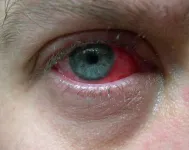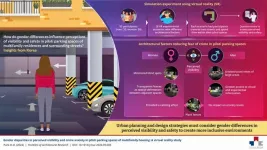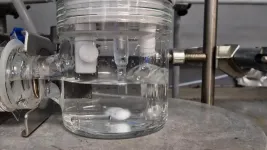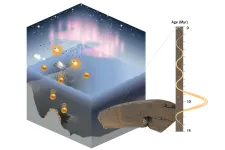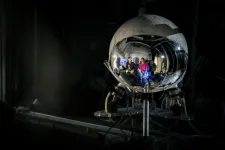(Press-News.org)
Graft-versus-host disease (GVHD) is a common and severe complication that occurs after stem cell transplantation, where the donor’s immune cells attack the recipient’s tissues. Ocular manifestation of GVHD is among the most challenging to treat, often leading to chronic inflammation and corneal tissue damage, which can result in loss of vision. Conventional treatments, including corticosteroids, are frequently used to manage ocular inflammation associated with GVHD. However, these therapies come with significant side effects, including the risk of glaucoma and other ocular complications.
Mesenchymal stromal cells (MSCs), a heterogeneous population of cells present in various tissues of the body, are known to possess immunoregulatory and modulatory properties. Their ability to navigate to sites that have suffered injury and inflammation in the body makes them highly sought after for the development of regenerative treatments and pharmaceuticals. In fact, several studies have explored the potential of human-derived MSCs for treating such conditions. However, much remains to be known about their true potential for the treatment of ocular GVHD and advancing their clinical application.
Now, in a new study conducted by Dr. Shigeto Shimmura and Robert M. Rusch from Fujita Health University and Keio University, Japan, researchers have proposed a novel therapy for ocular GVHD involving MSCs. The team explored the potential of regenerative mesenchymal stem cells in reducing ocular inflammation in GVHD-infected mice. Their study, published in The Ocular Surface, explores the potential of adipose-derived MSCs (adMSCs) to reduce inflammation and promote tissue repair. It was made available online on November 13, 2024, and published in Volume 34 of the journal in October 2024.
Elaborating on the rationale behind this study, Dr. Shimmura says, “adMSCs are easy to obtain and have demonstrated benefits in corneal tissue regeneration. Moreover, we injected adMSCs after the onset of GVHD and also monitored them over an extended period of time, helping us verify their therapeutic applicability.”
Using mice that had been induced with chronic GVHD, researchers administered adMSCs into the eyes via a single injection. Over three weeks, the researchers found that the adMSC treatment increased regulatory T cells while reducing inflammation in the mice. Further, adMSC-conditioned media enhanced cell migration and proliferation in laboratory scratch tests, showcasing the regenerative capacity of the cells. Importantly, the injected cells disappeared within a week, minimizing the risk of long-term complications such as tumor formation.
“Our findings highlight the dual benefits of adMSCs: They suppress inflammation and enhance tissue healing,” elaborates Dr. Shimmura, senior author and researcher. Adding further, he says, “This makes them a promising candidate for treating immune-related ocular disorders without systemic side effects.”
These observations point to the potential of adMSCs as a targeted, localized therapy for immune-related eye conditions. Unlike systemic treatments, these local injections ensured the therapeutic effects remained localized to the ocular surface. “Our work underscores the safety and efficacy of adMSCs, paving the way for clinical trials in humans,” notes Dr. Shimmura.
With their immunoregulatory and regenerative properties, adMSCs may offer a lifeline to patients suffering from chronic ocular GVHD and related inflammatory diseases. Future studies, however, need to focus on dose optimization and delivery methods to maximize therapeutic outcomes.
In summary, these results offer hope for a future where innovative, stem cell-based therapies can transform the way we manage autoimmune diseases, offering patients better outcomes and improved quality of life.
***
Reference
DOI: 10.1016/j.jtos.2024.11.001
About Fujita Health University
Fujita Health University is a private university situated in Toyoake, Aichi, Japan. It was founded in 1964 and houses one of the largest teaching university hospitals in Japan in terms of the number of beds. With over 900 faculty members, the university is committed to providing various academic opportunities to students internationally. Fujita Health University has been ranked eighth among all universities and second among all private universities in Japan in the 2020 Times Higher Education (THE) World University Rankings. THE University Impact Rankings 2019 visualized university initiatives for sustainable development goals (SDGs). For the “good health and well-being” SDG, Fujita Health University was ranked second among all universities and number one among private universities in Japan. The university became the first Japanese university to host the "THE Asia Universities Summit" in June 2021. The university’s founding philosophy is “Our creativity for the people (DOKUSOU-ICHIRI),” which reflects the belief that, as with the university’s alumni and alumnae, current students also unlock their future by leveraging their creativity.
Website: https://www.fujita-hu.ac.jp/en/index.html
About Professor Shigeto Shimmura from Fujita Health University
Shigeto Shimmura, MD, Ph.D., is a leading researcher in regenerative medicine and ophthalmology at Fujita Health University, Japan. His work focuses on innovative cell-based therapies for ocular diseases. With a strong background in immunology and stem cell biology, Dr. Shimmura has made significant contributions to understanding immune modulation and regenerative mechanisms in eye disorders, including graft-versus-host disease. He has 312 publications and 14,362 citations to his name.
Funding information
The study was supported by a grant from the Japan Society for the Promotion of Science (JSPS) (KAKENHI Grant #22H03245). The study was funded in part by Rohto Pharmaceuticals.
END
Multifamily residential buildings with multiple floors are common in South Korea. These buildings usually have pilotis—support structures like pillars that elevate the building, creating an open ground floor generally used for parking vehicles. These piloti parking spaces are often risky to navigate for pedestrians and residents due to limited visibility, unclear boundaries between adjacent areas, and poor management. For instance, these spaces have blind spots that criminals could exploit, which induces fear among people.
Though evidence-based architectural design strategies ...
Researchers have developed a sustainable catalyst that increases its activity during use while converting carbon dioxide (CO2) into valuable products. This discovery offers a blueprint for designing next-generation electrocatalysts.
A collaborative team from the University of Nottingham's School of Chemistry and the University of Birmingham have developed a catalyst made of tin microparticles supported by a nanotextured carbon structure. The interactions between the tin particles and graphitised ...
Years before tau tangles show up in brain scans of patients with Alzheimer's disease, a biomarker test developed at the University of Pittsburgh School of Medicine can detect small amounts of the clumping-prone tau protein and its misfolded pathological forms that litter the brain, cerebrospinal fluid and potentially blood, new research published today in Nature Medicine suggests.
The cerebrospinal fluid biomarker test correlates with the severity of cognitive decline, independent of other factors, including brain amyloid deposition, thereby opening doors for early-stage disease diagnosis ...
Beryllium-10, a rare radioactive isotope produced by cosmic rays in the atmosphere, provides valuable insights into the Earth's geological history. A research team from the Helmholtz-Zentrum Dresden-Rossendorf (HZDR), in collaboration with the TUD Dresden University of Technology and the Australian National University (ANU), has discovered an unexpected accumulation of this isotope in samples taken from the Pacific seabed. Such an anomaly may be attributed to shifts in ocean currents or astrophysical events that occurred approximately 10 million years ago. The findings hold the potential to serve as a global time marker, representing a promising ...
A new mathematical model sheds light on how the brain processes different cues, such as sights and sounds, during decision making. The findings from Princeton neuroscientists may one day improve how brain circuits go awry in neurological disorders, such as Alzheimer’s, and could help artificial brains, like Alexa or self-driving car technology, more helpful.
The findings were published February 10 in the journal Nature Neuroscience.
Walking to work, commuters encounter many sensory signals along their route, such as the glow of a crosswalk signal that indicates whether it’s safe to cross or beware of oncoming traffic. ...
Financial markets are reacting not just to Donald Trump's return to the White House but also to the unpredictability of this victory, according to a new study from the University of Surrey. Investors must diversify their portfolios to mitigate risks associated with political volatility and to remain vigilant about the potential for abrupt market corrections.
A new study, published in Economics Letters, indicates that while there was an immediate surge in stock prices following Trump's election, this was quickly tempered by investor concerns over potential trade wars and international instability.
A group of ...
Why do our mental images stay sharp even when we are moving fast? A team of neuroscientists led by Professor Maximilian Jösch at the Institute of Science and Technology Austria (ISTA) has identified a mechanism that corrects visual distortions caused by movement in animals. The study, conducted in mice, identifies a core function that can be generalized across the vertebrate visual system, including primates such as humans. The findings are published in Nature Neuroscience.
Despite its rapid development in recent decades, the video camera industry is still catching up with the capabilities of the human eye. In particular, action cams are designed ...
Euclid blasted off on its six-year mission to explore the dark Universe on 1 July 2023. Before the spacecraft could begin its survey, the team of scientists and engineers on Earth had to make sure everything was working properly. During this early testing phase, in September 2023, Euclid sent some images back to Earth. They were deliberately out of focus, but in one fuzzy image Euclid Archive Scientist Bruno Altieri saw a hint of a very special phenomenon and decided to take a closer look.
“I look at the data from Euclid as it comes in,” explains Bruno. “Even from that first observation, I could see it, but after Euclid made more observations of the area, ...
The report “Assessing Deep-Tech Innovation Hubs in Germany: The Case of Biotechnology” evaluates Germany’s performance in deep-tech innovation within biotech using a comprehensive index and examines five key hubs: Berlin, Heidelberg, Munich, Nuremberg-Erlangen, and Stuttgart. These hubs were analyzed in terms of fundamental research, research and development in biotech, startup activity, public infrastructure, and business environment.
Berlin, Munich, and Heidelberg are the leading biotech hubs
Berlin leads the index due to its strong public infrastructure ...
Experiencing pain may increase the odds that cancer survivors will use cigarettes and cannabis, according to a recent study published by Wiley online in CANCER, a peer-reviewed journal of the American Cancer Society. The study also found that cigarette smoking and pain are linked to more treatment-related side effects and worse health among cancer survivors.
Pain and use of cigarettes, e-cigarettes, alcohol, and cannabis commonly occur together in the general population. To characterize pain in relation to such non-opioid substance ...
